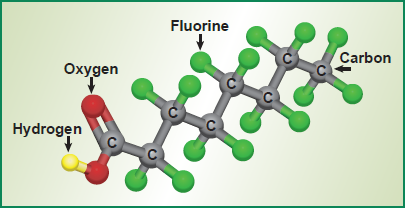PFAS continue to make headlines – and it’s all negative!
Regulations restricting PFAS use are increasing in number and scope. More data demonstrating their hazardous nature is being uncovered – all the time.
This is a 5-part blog series on Per- and polyfluoroalkyl substances (PFAS). This introductory post provides an overview of what they are and how they are hazardous.
What are PFAS?
PFAS are a class of synthetic, manmade chemicals that were first introduced to many industry and consumer products in the 1940’s. They are organofluorine (contain C-F bonds) chemical compounds that have multiple fluorine atoms attached to an alkyl chain. Technical definitions can be found at the EPA website and the OECD portal on PFAS.
They consist of a fully (per) or partly (poly) fluorinated carbon chain connected to different functional groups. Long chain (C8) PFAS have at least 8 carbons whereas short chain (C6) have 6 or fewer carbon atoms.

This is a huge class of chemical compounds. According to the OECD, there are at least 4730 different substances with at least three perfluorinated carbon atoms. The USEPA toxicity database, DSSTox, lists 8163 substances.
The illustration (photo credit NIEHS) shows a long chain PFAS called perfluorooctanoic acid (PFOA). Even though it is not manufactured anymore, PFOA is still found in the environment.
How are they hazardous?
Ongoing research has found evidence that PFAS exposure can lead to adverse health effects.
They are widely used across numerous industries, and do not decompose, nor do they easily break down. They are often referred to “forever chemicals” because some components break down very slowly over time, which means they basically remain in the environment forever.
Environmental Concerns
One of the environmental concerns is their persistence. For example, in 2009, Perfluorooctanesulfonic acid (PFOS), its salts and perfluorooctanesulfonyl fluoride, which are all C8 chemicals, were listed as persistent organic pollutants under the Stockholm Convention due to their ubiquitous, persistent, bioaccumulative and toxic nature.
Other than persistence, bioaccumulation and biomagnification are also causes for concern.
Bioaccumulation is when a hazardous substance gradually accumulates in an organism, which includes birds, marine life and mammals, and eventually these substances end up in our food supply.
We now know that PFAS residues are present in the blood of animals and humans all over the world as well as water, air, and soil across the globe. In fact, according to the CDC, 95% of the U.S. population have PFAS in their bodies.
Biomagnification is any concentration of a toxin in the tissues of organisms at successively higher levels in a food chain. Therefore, the top predators have higher levels of PFAS than species lower down the food chain.
Human Health concerns
Some PFAS are endocrine disruptors and linked to declining fertility rates. Others are potential carcinogens, with possible links to testicular and kidney cancer. Whilst others have may cause pregnancy induced hypertension and pre-eclampsia.
Do you need help with chemical management?
For help with sustainability, circularity and chemicals, contact Amanda Cattermole at (415) 412 8406 or Amanda@cattermoleconsulting.com. We can help you develop powerful solutions to protect your company and brand reputation.
Tips and Insights contains information to help you make informed sustainability decisions. Each post highlights a particular topic and includes questions you may want to consider for your business.

